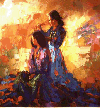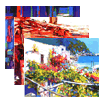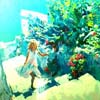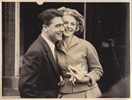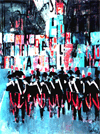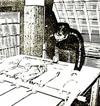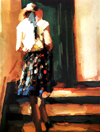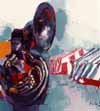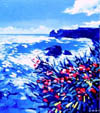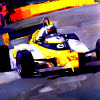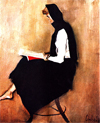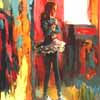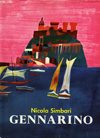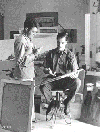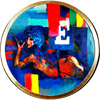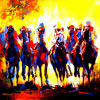The excitement I get every time I look through photographs and catalogues of Nicola’s work, is as strong today as it was 50-odd years ago. . .
The difference between the earlier works and the ones that followed is that SIMBARI “matured” into a great Master . . . using Colour and Light as his ‘signature’, creating the extra-ordinary Magic which captures the eye and imagination of those who see his Art.
|
His earlier paintings, show SIMBARI’s superb humour, full of Life, telling a story to the Viewer . . . It was LIFE . . . through his eyes . . . in Italy “Carabinieri in Galleria” Tempera on paper ©SIMBARI |
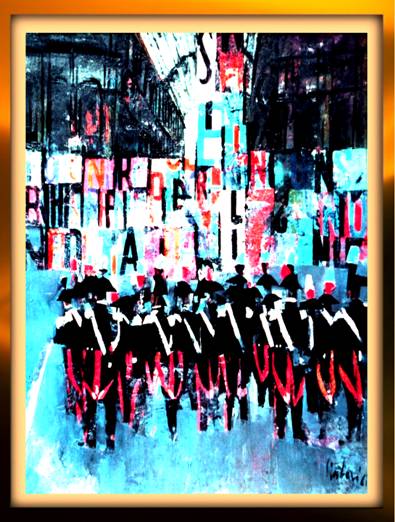 |
When I first met Nicola, he told me that he was a member of Tevere Remo, a Roman rowing club - - - saying that he got up at 5 a.m. each morning to train . . . . . I thought he was crazy!! . . .
As I got to know him better, I found out that he liked to tell ‘stories’, to see what reaction he got - - - All through our marriage, nothing has changed . . . But, I also learned that he was deadly serious about his deep-set Passion - - HIS ART.
Another characteristic, which never ceased to amaze me, was the neatness in his Studio . . . I had always been told of the disorderliness in artists’ studios, but this has never been true in the case of Nicola. His studio in Trastevere, where we lived for the first three years, was so tidy that it hardly seemed a “painter’s studio”. . . he was completely ‘professional’; he had no airs of “being an artist” . . .
This Studio, in Via dei Riari, was a very large, airy one-room living space (with a tiny kitchen and bathroom), and a huge terrace opening onto a view of the Botanical gardens of Villa Torlonia, just below the Gianiculum Hill (one of the 7 Hills of Rome). Every day the noon canon was sounded, and the whole studio shook!
Not far from this romantic hide-away, were Rome’s gaol, the river Tevere (Tiber), Castel Sant’Angelo, and The Vatican City - - - This was a Roman’s ROME, one where Simbari had been brought up, that he loved, and so often painted. “Lungo Tevere” - - “Campo dei Fiori” - - and so many more.
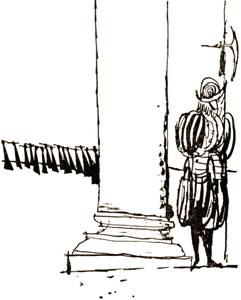 |
“Swiss Guard . . Piazza San
Pietro” ink drawing ©SIMBARI |
To know that Simbari’s formidable use of Colour evolved as he began to
enjoy his life as an Artist and as a Man, is to better understand their
importance, as he matured.
For me he has always been a Poet, a Musician, and a Storyteller writing
his personal Diary.
HIS life, and the life around him, was never concerned with trends and politics . . . he did not join a ‘group’, or ‘party’, or ‘clique of fashion’ . . .
![]() he was HIMSELF! Take it or leave it !
he was HIMSELF! Take it or leave it !
|
“Mercato a Porta Portese” Tempera on board ©SIMBARI |
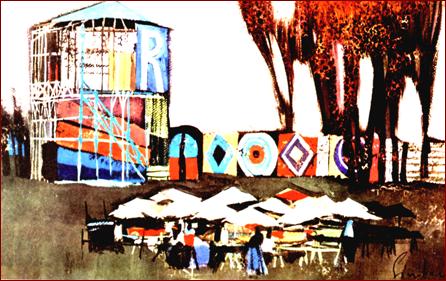 |
Nicola had an amazing gathering of friends and acquaintances from all over the world, from every background, doing incredible things . . . actors, journalists, painters and sculptors, writers, politicians, film and stage directors, great thinkers . . . they would gather at “Otello’s” (La Concordia Restaurant) or in Piazza Navona, or in Piazza del Popolo . . . and often in Simbari’s studio to discuss, or argue, or laugh and play music . . . this was SIMBARI’s “la Dolce Vita” . . . [meaning: “the sweet Life”] . . . and it WAS; Nicola, the showman! He loved every moment of the gatherings, and was always the centre of it all - - -
With THAT - - - the COLOURS began to appear - - -
|
“Sardinian Straw Hat” Acrylic on canvas ©SIMBARI |
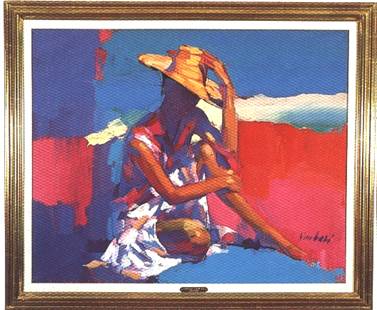 |
He received commissions to paint the “new” Pope, Pope John, and of the famous Italian actresses of the ‘50s, Anna Magnani, suddenly he was being asked to paint many more portraits . . . however, he felt portrait painting was tying, because the ‘client’ had to agree that the painting looked like them!
Later, I read, in an article, that Simbari couldn’t paint faces! . . . this is probably because he so often left the Viewer to imagine the central figure was, in his canvas, so he didn’t put in definite features!
There is so much to tell, about “discovering Simbari”, that it is difficult to put into words all the factors that has made him unique . . . perhaps it was his sensitivity - - or his sense fun - - or his joy of ‘being alive’, and doing what he loved most - - -
![]() writing his Diary with his artist’s brush . . .
writing his Diary with his artist’s brush . . .
More later!
© Elfrida 2010
Back to the top



